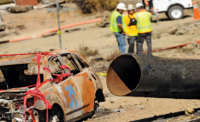The U.S. Dept. of Transportation has proposed a regulation to require automatic shutoff valves or similar technology on new and rebuilt pipelines that carry natural gas and hazardous liquids.
Under the proposed regulation, published in the Federal Register on Feb. 6, remote-control or automatic shutoff values must be installed on pipelines with diameters greater than 6 inches.
Systems to control leaks must be able to shut the valves to partition off damaged pipeline sections within 40 minutes of when a rupture is detected.
There would be some exceptions to the valve requirement. DOT says it “recognizes that there may be locations where it is not economically, technically or operationally feasible” to install such equipment.
In those instances, DOT is proposing to allow pipeline operators to install manual valves, “provided operators have a sufficient justification” for doing so.
The Interstate Natural Gas Association of America was pleased to see the proposal issued and is reviewing it, a spokesperson told ENR via email.
"While pipeline emergencies are rare, operators must be prepared for a quick and safe response," the spokesperson added. "Automated valve technology can be a valuable incident-response tool, when applied appropriately. "
The proposed regulation carries out a congressional mandate contained in the Pipeline Safety, Regulatory Certainty and Job Creation Act, which became law in 2012. [View ENR story on that law here.] It also is in line with a recommendation from the National Transportation Safety Board.
DOT Secretary Elaine Chao said in a statement, “This rule will improve critical safety requirements for the next generation of energy pipelines as U.S. energy production continues to grow.”
The department estimates the annual cost of complying with the rule at $3.1 million.
DOT’s Pipeline and Hazardous Materials Safety Administration will accept comments on the proposal until April 6.
In its proposal, DOT cites the 2010 rupture of a PG&E natural-gas pipeline in San Bruno, Calif., that killed eight. According to DOT, there was an “uncontrolled release of natural gas for 95 minutes, severely hampering firefighting efforts, before the operator closed the mainline valves.”
That rupture and resulting fire caused eight deaths and 51 injuries that required hospitalizations. It also destroyed 38 homes and damaged 70 others.




